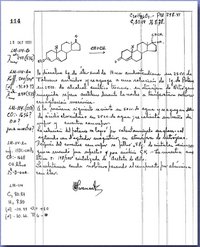WASHINGTON -- A highly effective, easily reversible intrauterine device that releases a low level of levonorgestrel and can be kept in place for up to 5 years will become available early this year.
The IUD, to be marketed under the trade name Mirena, has been available in Europe for 10 years. It was approved by the Food and Drug Administration last month and will be the third IUD on the U.S. market. In studies, Mirena had a 5-year cumulative failure rate below 1%, slightly below that of surgical sterilization.
IUD use among U.S. women has been extremely low, pegged at less than 1% of contraceptive users. But some features of Mirena could be especially appealing to certain women, according to two investigators in the U.S. trial of the device. They spoke during a teleconference on Mirena held by Berlex Laboratories, which is marketing the device in this country.
Because of its levonorgestrel component, spotting typically occurs for 3-6 months after insertion, but then bleeding gradually decreases and after 1 year, many women have no menstrual bleeding. This is a beneficial effect that "will make IUD convenience and efficacy available to women who might not have been able to use [other IUDs] before," said Dr. Anita Nelson, professor of ob.gyn. and medical director of the Women's Health Care Clinic, University of California, Los Angeles.
She noted that some women cannot use the ParaCard copper IUD because they already have heavy periods. This IUD, approved in 1988, is also extremely effective, but has the adverse effect of increasing menstrual bleeding by an average of 40%-50% and can increase cramping, said Dr. David Grimes, another investigator in the U.S. Mirena trial.
Although the Progestasert IUD, which releases 65 [micro]g of progesterone a day and was approved in 1976, also reduces menstrual bleeding and cramping, it is approved for only 1 year of use, said Dr. Grimes, vice president of biomedical affairs at Family Health International, a nonprofit reproductive health foundation in Research Triangle Park, N.C.
Mirena will be a "boon" for women who have heavy menstrual periods because it is associated with a 90% reduction in monthly blood loss, and one in five women eventually "will have no menstrual bleeding whatsoever," he said.
Both physicians also referred to the high efficacy rate and the immediate reversibility of the contraceptive after removal as other benefits of the device. Mirena's efficacy is "tantamount to surgical sterilization yet immediately reversible," Dr. Grimes said.
The applicator to be marketed with Mirena in the United States is different than that used in Europe and is designed so the IUD can be inserted with one hand. It is a "unique and clever inserter device that can be used with just a single hand so it leaves the clinicians other hand free to use instruments, said Dr. Grimes, also of the University of North Carolina, Chapel Hill.
Because Mirena requires different IUD insertion techniques than those used in the past, providers will need to get hands-on experience and formal training before they start providing Mirena to patients, according to Dr. Nelson. She added that the device should be inserted during the first 5 days of the menstrual cycle.
Mirena works by preventing fertilization, although it's not clear exactly how this is accomplished. "It's probably a combination of effects, including an effect on cervical mucus, preventing the sperm from getting through and reducing the ability of sperm to swim," as well as an effect on the uterine lining, Dr. Grimes said.
During the teleconference, Dr. Marie Foegh, director of clinical research and development at Berlex, Montville, N.J., said that when the device is prescribed for women in the postpartum period, it is best to wait for 3-6 weeks after delivery before insertion.
In the U.S. trial, the most common side effects occurred during the first few months after insertion and subsided with prolonged use. These were back pain, breast tenderness, headache, mood changes, and nausea.
She said that appropriate candidates for Mirena are in mutually monogamous, stable relationships; have had at least one child; and have no history of pelvic inflammatory disease (PID) or ectopic pregnancy or a condition that predisposes them to ectopic pregnancy.
Dr. Grimes cited two studies of Mirena that found no increased risk of PID associated with this device: One study suggested that the device had no effect on PID rates; the other showed that it was associated with a lower PID risk.
Berlex has started enrolling women in a large multicenter study in the United States to evaluate the Mirena insertion procedure, patient counseling, and patient satisfaction with the device.
COPYRIGHT 2001 International Medical News Group
COPYRIGHT 2001 Gale Group



